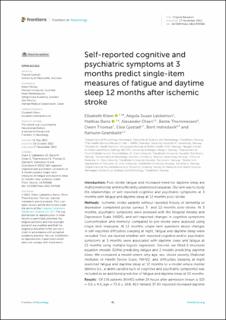| dc.description.abstract | Introduction: Post-stroke fatigue and increased need for daytime sleep are multidimensional and insufficiently understood sequelae. Our aim was to study the relationships of self-reported cognitive and psychiatric symptoms at 3 months with fatigue and daytime sleep at 12 months post-stroke.
Methods: Ischemic stroke patients without reported history of dementia or depression completed postal surveys 3- and 12-months post-stroke. At 3 months, psychiatric symptoms were assessed with the Hospital Anxiety and Depression Scale (HADS), and self-reported changes in cognitive symptoms (concentration and memory) compared to pre-stroke were assessed using single-item measures. At 12 months, single-item questions about changes in self-reported difficulties sleeping at night, fatigue and daytime sleep were included. First, we studied whether self-reported cognitive and/or psychiatric symptoms at 3 months were associated with daytime sleep and fatigue at 12 months using multiple logistic regression. Second, we fitted 2 structural equation models (SEMs) predicting fatigue and 2 models predicting daytime sleep. We compared a model where only age, sex, stroke severity (National Institutes of Health Stroke Scale; NIHSS), and difficulties sleeping at night predicted fatigue and daytime sleep at 12 months to a model where mental distress (i.e., a latent variable built of cognitive and psychiatric symptoms) was included as an additional predictor of fatigue and daytime sleep at 12 months.
Results: Of 156 patients (NIHSS within 24 hours after admission (mean ± SD) = 3.6 ± 4.3, age = 73.0 ± 10.8, 41% female) 37.9% reported increased daytime sleep and 50.0% fatigue at 12 months. Increased psychiatric symptoms and worsened cognitive symptoms were associated with fatigue and daytime sleep at 12 months, after controlling for NIHSS, age, sex, and difficulties sleeping at night. SEM models including mental distress as predictor showed adequate model fit across 3 fit measures (highest RMSEA = 0.063, lowest CFI and TLI, both 0.975). Models without mental distress were not supported.
Conclusion: Self-reported cognitive and psychiatric symptoms at 3 months predict increased daytime sleep and fatigue at 12 months. This highlights the relevance of monitoring cognitive and psychiatric symptoms in the subacute phase post-stroke. However, future research using validated measures of self-reported symptoms are needed to further explore these relationships. | en_US |

